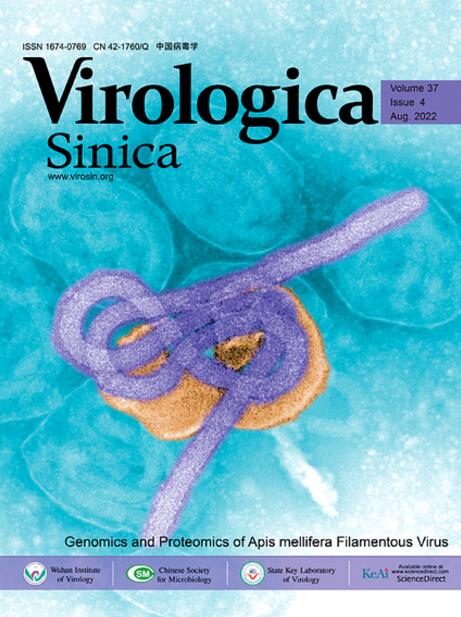产生并鉴定对 SfMNPV 和 AcMNPV 均敏感的新型卵巢细胞系。
IF 5.5
3区 医学
Q1 Medicine
引用次数: 0
摘要
鞘翅目多核多角体病毒(Spodoptera frugiperda multiple nucleopolyhedrovirus,SfMNPV)属于鞘翅目多核多角体病毒(Alphabaculovirus spofrugiperdae),最近已在中国登记为杀虫剂。该病毒对全球主要农业害虫鞘翅目蚜虫(Spodoptera frugiperda)具有特异性作用。要深入了解病毒感染、复制过程以及病毒颗粒的复杂形成,使用细胞系进行体外研究是必不可少的工具。虽然源自鞘翅目蚜虫的 IPLB-Sf9 和 IPLB-Sf21 细胞系被广泛用于研究加州伯劳多核多面体病毒(AcMNPV)的感染和复制机制,但它们在 SfMNPV 感染后产生病毒多面体的能力并不理想。为了解决这个问题,我们从中国云南的俭蝽种群中培育出了一种名为 IOZCAS-Sf-1 的新型细胞系。线粒体 COX1 基因分析证实了 IOZCAS-Sf-1 细胞系的物种来源。此外,还进行了一项比较研究,将这一新型细胞系的 COX1 基因序列与 IPLB-Sf9 的 COX1 基因序列进行了对比,突出了两者之间的区别。重要的是,IOZCAS-Sf-1 细胞在分别感染 AcMNPV 和 SfMNPV 后,都表现出了生成多面体的显著能力。因此,这一细胞系被认为是一种有前途的宝贵资源。它不仅可用于研究病毒复制的分子机制及其对宿主细胞的影响,还可用于探索 SfMNPV DNA 的转染效率。这一探索进一步拓展了其在 DNA 重组实验中的潜在应用,为开发更有效的生物农药和可持续农业实践奠定了理论基础。本文章由计算机程序翻译,如有差异,请以英文原文为准。
Generation and characterization of a novel ovariole cell line derived from Spodoptera frugiperda in China with sensitivity to both SfMNPV and AcMNPV
Spodoptera frugiperda multiple nucleopolyhedrovirus (SfMNPV), belonging to the species Alphabaculovirus spofrugiperdae, has been recently registered as an insecticide in China. This virus has a specific effect on the global major agricultural pest Spodoptera frugiperda. To gain insights into viral infection, replication processes, and the complex formation of viral particles, in vitro studies using cell lines are essential tools. Although the IPLB-Sf9 and IPLB-Sf21 cell lines derived from S. frugiperda are widely used for studies on the infection and replication mechanisms of Autographa californica multiple nucleopolyhedrovirus (AcMNPV), their capacity to produce viral polyhedra after SfMNPV infection is not optimal. To address this limitation, a novel cell line named IOZCAS-Sf-1 was developed from a S. frugiperda population in Yunnan, China. The mitochondrial COX1 gene analysis confirmed the species origin of the IOZCAS-Sf-1 cell line. Furthermore, a comparative study was carried out to contrast the COX1 gene sequence of this novel cell line with that of IPLB-Sf9, highlighting the distinctions between the two. Importantly, the IOZCAS-Sf-1 cells exhibited a remarkable ability to generate polyhedra when infected with AcMNPV and SfMNPV, respectively. Consequently, this cellular lineage is considered a promising and valuable resource. It serves not only to investigate the molecular mechanisms of viral replication and its impact on host cells, but also to explore the transfection efficiency of SfMNPV DNA. This exploration further expands into its potential application in recombinant DNA experiments, laying a theoretical groundwork for the advancement of more effective biopesticides and sustainable agricultural practices.
求助全文
通过发布文献求助,成功后即可免费获取论文全文。
去求助
来源期刊

Virologica Sinica
Biochemistry, Genetics and Molecular Biology-Molecular Medicine
CiteScore
7.70
自引率
1.80%
发文量
3149
期刊介绍:
Virologica Sinica is an international journal which aims at presenting the cutting-edge research on viruses all over the world. The journal publishes peer-reviewed original research articles, reviews, and letters to the editor, to encompass the latest developments in all branches of virology, including research on animal, plant and microbe viruses. The journal welcomes articles on virus discovery and characterization, viral epidemiology, viral pathogenesis, virus-host interaction, vaccine development, antiviral agents and therapies, and virus related bio-techniques. Virologica Sinica, the official journal of Chinese Society for Microbiology, will serve as a platform for the communication and exchange of academic information and ideas in an international context.
Electronic ISSN: 1995-820X; Print ISSN: 1674-0769
 求助内容:
求助内容: 应助结果提醒方式:
应助结果提醒方式:


